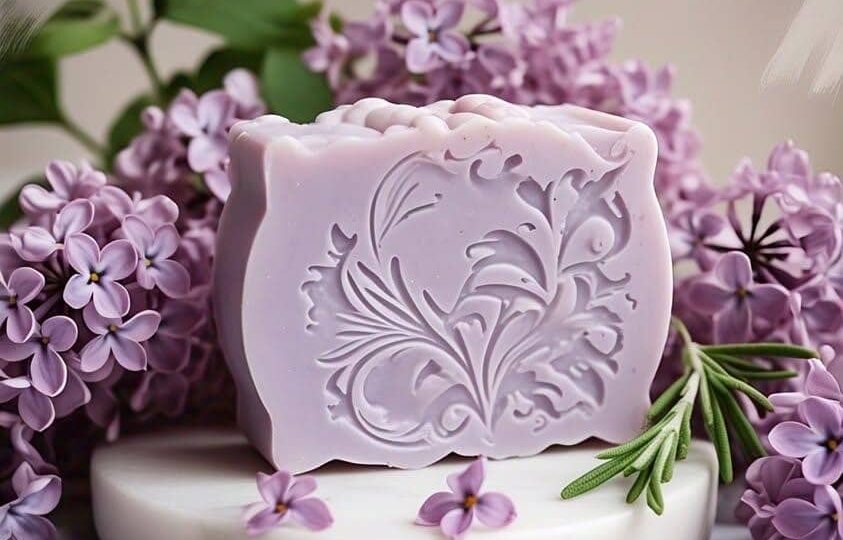Lilac flowers, with their vibrant purple petals and sweet fragrance, have long been admired for their beauty and symbolism of love and renewal. Beyond their visual and aromatic appeal, lilacs are packed with skin benefits that make them an excellent addition to your skincare routine. When transformed into soap, lilac offers a refreshing, floral cleanse that not only hydrates the skin but also soothes, nourishes, and promotes a glowing complexion. In this blog, we’ll explore the benefits of lilac soap, the ingredients you’ll need to make it, and an easy method for crafting your own beautiful bar of lilac soap at home.
The Benefits of Lilac Soap
Lilac soap is an exquisite treat for your skin, offering numerous benefits that go beyond just a refreshing fragrance. Here’s why lilac soap should be a staple in your skincare routine:
- Soothes and Calms Skin: Lilac has natural anti-inflammatory properties that help calm irritated, sensitive, or red skin. It is an ideal option for soothing conditions like sunburn, rashes, or eczema.
- Hydrates and Moisturizes: Lilac soap contains ingredients that lock in moisture, making it perfect for dry and dehydrated skin. Its hydrating properties ensure your skin stays soft and smooth without feeling greasy.
- Brightens and Revives Skin: Lilac is rich in antioxidants, which help promote healthy skin regeneration and combat free radical damage. This results in a brighter, more even skin tone, giving you a radiant complexion.
- Antibacterial and Antifungal Properties: Lilac flowers contain natural antibacterial and antifungal agents that help cleanse the skin, making lilac soap an excellent choice for acne-prone skin and preventing breakouts.
- Promotes Relaxation: The sweet, floral scent of lilac has calming effects on the mind and body. Using lilac soap can help reduce stress and create a peaceful, spa-like experience in your daily routine.
- Anti-Aging Effects: The antioxidants in lilac help combat the signs of aging, such as wrinkles and fine lines. Regular use of lilac soap can promote youthful, healthy-looking skin by supporting collagen production.
Ingredients for Homemade Lilac Soap
Making lilac soap at home is simple and requires a few natural ingredients. Here’s what you’ll need:
- Lilac Flowers or Lilac Essential Oil: The main ingredient that brings the benefits of lilac to the soap. You can use fresh or dried lilac flowers or opt for lilac essential oil for a more concentrated effect.
- Soap Base: Choose a mild soap base like glycerin, shea butter, or olive oil for a gentle and moisturizing base.
- Coconut Oil: Coconut oil enhances the soap’s lather and adds moisture to the skin. It also has antibacterial properties, which support clean, healthy skin.
- Olive Oil: Olive oil is rich in antioxidants and fatty acids, helping to nourish and hydrate the skin.
- Honey (Optional): Honey is a natural humectant, drawing moisture into the skin and keeping it soft and hydrated. It also has antibacterial and anti-inflammatory properties.
- Essential Oils (Optional): You can enhance the fragrance and therapeutic benefits of the soap by adding other essential oils like lavender, chamomile, or rose to complement the lilac aroma.
How to Make Homemade Lilac Soap
Making lilac soap at home is straightforward. Here’s a simple recipe to guide you through the process:
Materials Needed:
- 1 lb soap base (glycerin, shea butter, or olive oil)
- 1-2 tablespoons dried lilac flowers or 10-15 drops lilac essential oil
- 2 tablespoons coconut oil
- 1 tablespoon olive oil
- 1 tablespoon honey (optional)
- Soap mold
Method:
- Melt the Soap Base: Cut the soap base into small cubes and melt it in a double boiler or microwave. Stir occasionally to ensure the soap melts evenly.
- Add Coconut Oil and Olive Oil: Once the soap base is melted, add coconut oil and olive oil. These oils will help nourish and hydrate your skin.
- Add Honey (Optional): Stir in honey for added moisture and antibacterial benefits. Honey will also give your soap a smooth texture.
- Add Lilac Flowers or Essential Oil: If you’re using dried lilac flowers, stir them into the soap mixture. If you’re using lilac essential oil, add 10-15 drops for a fragrant infusion.
- Add Additional Essential Oils (Optional): If desired, add a few drops of other essential oils like lavender or chamomile to complement the lilac scent.
- Pour into Soap Mold: Pour the mixture into a soap mold and spread it evenly.
- Let It Cool and Set: Allow the soap to cool and set for several hours. You can place it in the refrigerator to speed up the process.
- Remove and Store: Once the soap has hardened, remove it from the mold and store it in a cool, dry place. Your homemade lilac soap is now ready for use!
How to Use Lilac Soap
Lilac soap can be used in several ways to enhance your skincare routine:
- Facial Cleanser: Lilac soap is gentle enough to use on the face. It helps cleanse, hydrate, and calm the skin while promoting a brighter complexion.
- Body Soap: Use lilac soap as a body wash to hydrate and soothe dry or irritated skin. It leaves your skin feeling soft and refreshed.
- Hand Soap: Lilac soap is perfect as a hand wash, keeping your hands moisturized and clean without drying them out.
- Bath Soap: Add lilac soap to your bath for a relaxing, aromatic experience. The calming fragrance and moisturizing properties make it a perfect addition to your bath routine.
Conclusion
Homemade lilac soap is a luxurious, natural addition to your skincare routine. With its soothing, hydrating, and anti-aging properties, lilac soap helps promote soft, glowing skin while providing a relaxing, floral experience. Whether you’re using it as a facial cleanser, body wash, or hand soap, lilac soap offers a refreshing, spa-like treat for your skin. Try making your own lilac soap today and enjoy the many benefits of this beautiful, fragrant flower.





